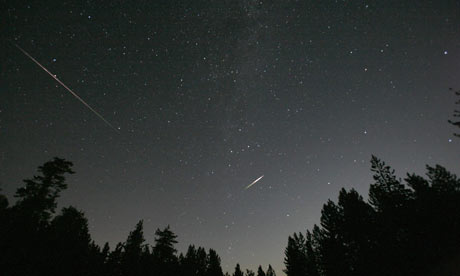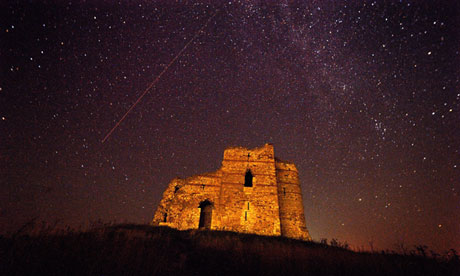
Meteors from the
Perseid shower streak past stars above the Los Padres national forest in
California on 12 August 2009.
Wait until late at night. If the sky is clear, find the darkest site you can with a clear eastern horizon. Plonk yourself down in the chair facing east, cover up with the blanket and wait. The Perseid meteor shower is expected to peak in the pre-dawn skies on both 12 and 13 August.
The Perseids were once part of comet Swift-Tuttle. At 27 kilometres across, this is one of the largest. It orbits the sun every 133 years and last passed by in 1992. Whenever it approaches, the heat of the sun disintegrates its ice, creating a dusty tail and replenishing the Perseid stream. The Earth passes through this stream every August, sparking the meteor shower.
Each one of the meteors, sometimes called shooting stars, that you see is a tiny speck of dust as old as the formation of Earth and the other planets, 4.6bn years ago. It burns with incandescent glory because it has hit our atmosphere at a speed of 160,000 kilometres per hour (100,000 miles per hour).
This creates a shockwave that compresses a pocket of air in front of the dust grain and raises it to a temperature of a few thousand degrees. This is enough to burn up the dust and create a bright meteor.
Swift Tuttle is the largest object to regularly pass Earth. Its orbit is known well enough for astronomers to believe it does not pose a collision hazard for at least the next 2,000 years.

A Perseid meteor over the Roman castle of Bukelon, near Matochina in Bulgaria, on 13 August 2010. Photograph: Vassil Donev/EPA
The Perseids are generally considered the most active and reliable of the 64 meteor showers that Earth passes through every year. A recent Nasa study found that it offers the best chance out of all the meteor showers of seeing an ultra-bright meteor called a fireball.
Even if you don't see a fireball, you are guaranteed that there will be dozens of ordinary meteors every hour – providing the sky is clear and you can stay awake.